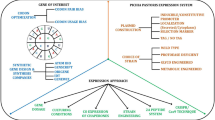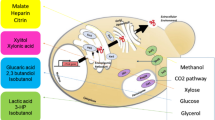Abstract
Rhizopus lipases have been successfully expressed in Pichia pastors and different fermentation strategies have been investigated. However, there is no sufficient study on the effects of methanol concentration on the production of Rhizopus lipases in P. pastors. In this study, the lipase from Rhizopus chinensis CCTCC M20102 was expressed under different fed-batch fermentation conditions at methanol concentrations ranging from 0.5 to 3.5 g/L. The lipase activity, stability, and productivities were analyzed. The optimum methanol concentration was 1 g/L, with the highest lipase activity of 2,130 U/mL, without degradation. Additional information was obtained from the analysis of methanol consumption and production rates. The results also suggested that the cell concentration at the end of the glycerol fed-batch phase was very important for cell viability and protease activity.
Similar content being viewed by others
References
Reetz, M. T. (2002) Lipases as practical biocatalysts. Curr. Opin. Chem. Biol. 6: 145–150.
Ghanem, A. and H. Y. Aboul-Enein (2005) Application of lipases in kinetic resolution of racemates. Chirality 17: 1–15.
Macauley-Patrick, S., M. L. Fazenda, B. McNeil, and L. M. Harvey (2005) Heterologous protein production using the Pichia pastoris expression system. Yeast 22: 249–270.
Minning, S., A. Serrano, P. Ferrer, C. Sola, R. D. Schmid, and F. Valero (2001) Optimization of the high-level production of Rhizopus oryzae lipase in Pichia pastoris. J. Biotechnol. 86: 59–70.
Resina, D., A. Serrano, F. Valero, and P. Ferrer (2004) Expression of a Rhizopus oryzae lipase in Pichia pastoris under control of the nitrogen source-regulated formaldehyde dehydrogenase promoter. J. Biotechnol. 109: 103–113.
Brocca, S., C. Schmidt-Dannert, M. Lotti, L. Alberghina, and R. D. Schmid (1998) Design, total synthesis, and functional overexpression of the Candida rugosa lip1 gene coding for a major industrial lipase. Protein Sci. 7: 1415–1422.
Brunel, L., V. Neugnot, L. Landucci, W. N. Boze, G. Moulin, F. Bigey, and E. Dubreucq (2004) High-level expression of Candida parapsilosis lipase/acyltransferase in Pichia pastoris. J. Biotechnol. 111: 41–50.
Rotticci-Mulder, J. C., M. Gustavsson, M. Holmquist, K. Hult, and M. Martinelle (2001) Expression in Pichia pastoris of Candida antarctica lipase B and lipase B fused to a cellulose-binding domain. Protein Expr. Purif. 21: 386–392.
Xu, Y., D. Wang, X. Q. Mu, G. A. Zhao, and K. C. Zhang (2002) Biosynthesis of ethyl esters of short-chain fatty acids using whole-cell lipase from Rhizopus chinesis CCTCC M201021 in non-aqueous phase. J. Mol. Catal. B-Enzym. 18: 29–37.
Yu, X. W., L. L. Wang, and Y. Xu (2009) Rhizopus chinensis lipase: Gene cloning, expression in Pichia pastoris and properties. J. Mol. Catal. B-Enzym. 57: 304–311.
Stratton, J., V. Chiruvolu, and M. Meagher (1998) High cell-density fermentation. Methods Mol. Biol. 103: 107–120.
Bushell, M. E., M. Rowe, C. A. Avignone-Rossa, and J. N. Wardell (2003) Cyclic fedbatch culture for production of human serum albumin in Pichia pastoris. Biotechnol. Bioeng. 82: 678–683.
Sinha, J., B. A. Plantz, W. Zhang, M. Gouthro, V. Schlegel, C.-P. Liu, and M. M. Meagher (2003) Improved production of recombinant ovine Interferon-t by Mut+ strain of Pichia pastoris using an optimized methanol feed profile. Biotechnol. Prog. 19: 794–802.
Wen, H. B., X. H. Cao, J. T. Tang, and Y. B. Han (2009) Effects of components in the culture solution on peptides accumulation during germination of brown rice. Eur. Food. Res. Technol. 228: 959–967.
Kordel, M., B. Hofmann, D. Schomburg, and R. D. Schmid (1991) Extracellular lipase of Pseudomonas sp. strain Atcc-21808: Purification, characterization, crystallization, and preliminary-X-ray diffraction data. J. Bacteriol. 173: 4836–4841.
Sitia, R. and I. Braakman (2003) Quality control in the endoplasmic reticulum protein factory. Nature 426: 891–894.
Liu, Y. Y., J. H. Woo, and D. M. Neville (2005) Overexpression of an anti-CD3 immunotoxin increases expression and secretion of molecular chaperone BiP/Kar2p by Pichia pastoris. Appl. Environ. Microbiol. 71: 5332–5340.
Mattanovich, D., B. Gasser, H. Hohenblum, and M. Sauer (2004) Stress in recombinant protein producing yeasts. J. Biotechnol. 113: 121–135.
Beer, H. D., G. Wohlfahrt, R. D. Schmid, and J. E. G. McCarthy (1996) The folding and activity of the extracellular lipase of Rhizopus oryzae are modulated by a prosequence. Biochem. J. 319: 351–359.
Hama, S., S. Tamalampudi, T. Fukumizu, K. Miura, H. Yamaji, A. Kondo, and H. Fukuda (2006) Lipase localization in Rhizopus oryzae cells immobilized within biomass support particles for use as whole-cell biocatalysts in biodiesel-fuel production. J. Biosci. Bioeng. 101: 328–333.
Cereghino, J. L. and J. M. Cregg (2000) Heterologous protein expression in the methylotrophic yeast Pichia pastoris. FEMS. Microbiol. Rev. 24: 45–66.
Cos, O., A. Serrano, J. L. Montesinos, P. Ferrer, J. M. Cregg, and F. Valero (2005) Combined effect of the methanol utilization (Mut) phenotype and gene dosage on recombinant protein production in Pichia pastoris fed-batch cultures. J. Biotechnol. 116: 321–335.
Surribas, A., R. Stahn, J. L. Montesinos, S. O. Enfors, F. Valero, and M. Jahic (2007) Production of a Rhizopus oryzae lipase from Pichia pastoris using alternative operational strategies. J. Biotechnol. 130: 291–299.
Kohno, M., M. Enatsu, M. Yoshiizumi, and W. Kugimiya (1999) High-level expression of Rhizopus niveus lipase in the yeast Saccharomyces cerevisiae and structural properties of the expressed enzyme. Protein Expr. Purif. 15: 327–335.
Niu, W. N., Z. P. Li, and T. W. Tan (2006) Secretion of pro- and mature Rhizopus arrhizus lipases by Pichia pastoris and properties of the proteins. Mol. Biotechnol. 32: 73–81.
Cunha, A. E., J. J. Clemente, R. Gomes, F. Pinto, M. Thomaz, S. Miranda, R. Pinto, D. Moosmayer, P. Donner, and M. J. T. Carrondo (2004) Methanol induction optimization for scFv antibody fragment production in Pichia pastoris. Biotechnol. Bioeng. 86: 458–467.
Author information
Authors and Affiliations
Corresponding author
Rights and permissions
About this article
Cite this article
Wu, D., Yu, X.W., Wang, T.C. et al. High yield Rhizopus chinenisis prolipase production in Pichia pastoris: Impact of methanol concentration. Biotechnol Bioproc E 16, 305–311 (2011). https://doi.org/10.1007/s12257-009-3021-4
Received:
Revised:
Accepted:
Published:
Issue Date:
DOI: https://doi.org/10.1007/s12257-009-3021-4




